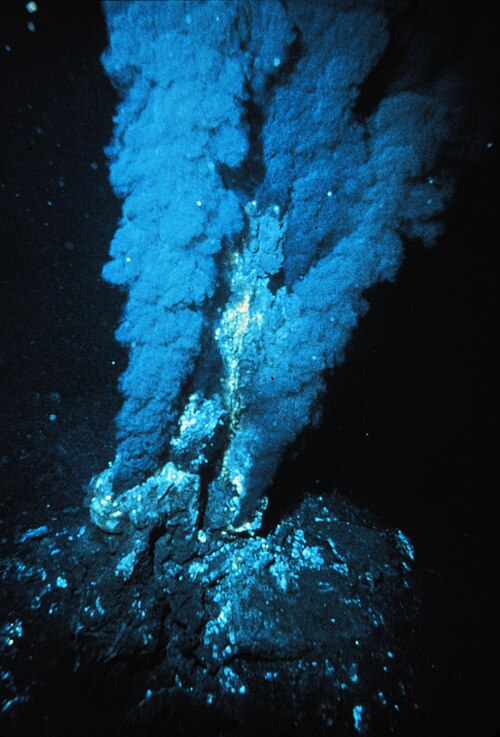Facts for Kids
Hydrothermal vents are underwater geysers that emit superheated, mineral-rich water, supporting unique ecosystems in extreme marine environments.
Overview
Impact Of Climate Change
Types Of Hydrothermal Vents
Formation Of Hydrothermal Vents
Exploration And Research Methods
Chemosynthesis And Energy Sources
Human Activities And Conservation
Ecosystems Around Hydrothermal Vents
Future Of Hydrothermal Vent Research

Inside this Article
Climate Change
Marine Biology
Earth's Crust
Temperature
Discovery
Hydrogen
Bacteria
Calcium
People
Did you know?
🌊 Hydrothermal vents are found at the bottom of the ocean where tectonic plates meet.
🔥 These vents release superheated water that can exceed temperatures of 400°C (752°F).
🌱 Unique ecosystems thrive around hydrothermal vents, relying on chemosynthesis rather than photosynthesis.
🐚 Giant tube worms, clams, and various types of extremophiles are some organisms found at these vents.
⚗️ Hydrothermal vents are rich in minerals, providing essential nutrients to the surrounding habitats.
🌍 The discovery of hydrothermal vents in 1977 changed our understanding of life in extreme environments.
🦠 The bacteria living near vents are capable of converting toxic substances into energy.
🐋 Many marine species migrate to hydrothermal vents for feeding purposes.
📏 Some hydrothermal vent fields can stretch for miles along the ocean floor.
🔬 Research on hydrothermal vents helps scientists understand potential life on other planets.
Introduction
They are like underwater hot springs, usually located along the ocean floor, especially in areas known as mid-ocean ridges. The temperature near these vents can reach up to 400 degrees Celsius (752 degrees Fahrenheit). What makes them fascinating is that they release super-heated water rich in minerals! These vents create unique ecosystems where many unusual creatures live, such as tube worms, giant clams, and colorful shrimp. 🦞
Scientists are excited to study hydrothermal vents because they help us understand the amazing life and chemistry of our oceans.
Impact Of Climate Change
️ Rising sea temperatures and increased acidity can change the delicate balance of life around these vents. For example, if the water gets too warm, it can harm the creatures that depend on the vents for survival. 🦐
Scientists worry that climate change may disrupt food webs in these unique ecosystems. Protecting hydrothermal vents is important because they play a role in keeping our oceans healthy! 🌊
Monitoring changes helps us understand how to save these underwater treasures before they are in danger.
Types Of Hydrothermal Vents
️ Black smokers release very hot, dark water filled with minerals like iron and sulfide. The black color usually comes from minerals that cool and settle around the vent, forming tall chimney-like structures. White smokers, on the other hand, release cooler water that is rich in lighter-colored minerals like barium and calcium. 💧
Both types support different kinds of life, but they share the same unique and extreme environments that allow extraordinary organisms to thrive!
Formation Of Hydrothermal Vents
The water travels deep down, where it gets heated by magma, which is hot, melted rock beneath the Earth's surface. When this super-heated water pushes back up through the cracks, it carries minerals from the Earth's crust. These minerals mix with the water and create the unique conditions needed for life to thrive! Just like a volcano, when the super-hot water erupts, it can create structures called chimneys, which can reach heights of over 60 meters (almost 200 feet)! 🏔
️
Exploration And Research Methods
These machines can dive deep into the ocean, often over 2,500 meters (8,200 feet) down, to find and study these vents. 🎥
They gather samples of water, minerals, and even living creatures. Programs like the Deep-Sea Research Cruises and the Alvin submersible have helped discover many hydrothermal vent sites. By studying these unique places, scientists learn more about how life can exist in extreme environments, and how the Earth’s geology affects marine biology! 🌐
Chemosynthesis And Energy Sources
️ Chemosynthesis is when bacteria convert chemicals from the vents, like hydrogen sulfide, into energy. This is different from photosynthesis, which is what plants use to turn sunlight into energy! 🌱
The bacteria provide food for many creatures living in these ecosystems, like tube worms and clams, which rely on them to survive. This means that life in these dark, deep ocean areas is truly amazing and adapted to the extreme conditions without sunlight! 🌌
Human Activities And Conservation
These actions can potentially damage delicate ecosystems. 🚫
To protect hydrothermal vents, scientists and governments are working together to create marine protected areas. These are special zones where human activities are limited or prohibited. Additionally, raising awareness about the importance of these habitats helps people understand why we should care for them! 🛡
️ By caring for the oceans and their unique ecosystems, we can help ensure that hydrothermal vents remain a thriving home for many remarkable creatures! 🐚
Ecosystems Around Hydrothermal Vents
Tube worms, which can grow up to 3 meters long, are one of the most famous creatures there. They don’t have mouths or digestive systems; instead, they rely on bacteria for food! 🦠
These bacteria convert the chemicals from the vents into energy, creating a food source for many organisms. Other creatures that live near vents include giant clams, crabs, and various fish. These fascinating organisms have specially adapted to the extreme pressures, temperatures, and chemical-rich waters of the ocean floor! 🐟
Future Of Hydrothermal Vent Research
Scientists are excited to continue exploring these mysterious underwater worlds. New technologies, like advanced robotics and sensors, will allow us to learn even more about these ecosystems. 🌊
Future research may reveal new species and help us understand how life can exist in extreme conditions, possibly even on other planets! 🪐
By studying hydrothermal vents, we not only learn about Earth but also about the possibilities for life beyond our planet! Each discovery brings us closer to understanding the amazing connections in our oceans! 🌌

